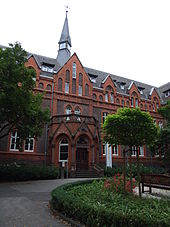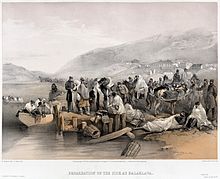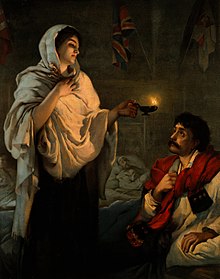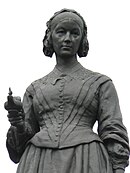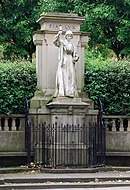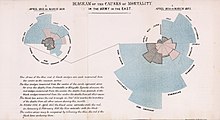Florence nightingale
Florence Nightingale (Florence, May 12, 1820-London, August 13, 1910) was a British nurse, writer and statistician, considered a forerunner of contemporary professional nursing and creator of the first model nursing concept. She excelled in mathematics from a very young age, and she completed her studies and applied her knowledge of statistics to epidemiology and health statistics. She was the first woman to be admitted to the British Royal Statistical Society, and an honorary member of the American Statistical Association.
She laid the foundations for the professionalization of nursing with the establishment, in 1860, of her school of nursing at Saint Thomas' Hospital in London, now an integral part of King's College London and the NHS. the first secular nursing school in the world.
His work was the source of inspiration for Henri Dunant, founder of the Red Cross and author of the humanitarian proposals adopted by the Geneva convention.
Of Anglican faith, she believed that God had inspired her to be a nurse. She achieved worldwide fame for her pioneering nursing work in assisting the wounded during the Crimean War. From that moment on she was known as "the lady with the lamp", because of her habit of making night rounds with a lamp to attend to her patients.
In 1883, Queen Victoria awarded her the Royal Red Cross, and in 1907 she became the first woman to receive the UK Order of Merit. In 1908, she was awarded the Keys to the City of London.
The Nightingale Pledge sworn by graduating nurses was created in her honor in 1893. International Nursing Day is celebrated on her birthday.
Biography
Early Years
He was born into an upper-class British family in Villa Colombaia, Florence, and was named after his hometown, then the capital of the Grand Duchy of Tuscany. His older sister, Frances Parthenope, was also named after her birthplace, Parthenopolis, a Greek settlement near Naples.
Her parents were William Edward Nightingale, born William Edward Shore (1794-1874), and Frances "Fanny" Smith (1789-1880). William's mother, Mary Evans, was the niece of Peter Nightingale, due to which William inherited his estate in Derbyshire and assumed the Nightingale name and arms. Fanny's father (Florence's maternal grandfather) was the abolitionist and Unitarian William Smith.
Inspired by what she interpreted as a call from God, she announced in February 1837, while at Embley Park, her decision to take up nursing from 1844. This decision challenged the social conventions of the time, where the woman was destined to fulfill the role of wife and mother. After many sacrifices and strong opposition from her family, especially from her mother and her sister, she managed to train as a nurse. The politician and poet Richard Monckton Milnes, who would be one of her strongest political and intellectual supporters, came to propose to her, but she rejected her proposal, convinced that it would interfere with her decision to devote herself to nursing. She also maintained a close relationship with Benjamin Jowett, who is presumed to have proposed to her.
In Rome in 1847 he met Sidney Herbert, a young politician who was on his honeymoon and with whom he began a friendship that was decisive for his projects, thanks to the support he would give him when he occupied the Secretary of War years later.
She continued her travels (now with Charles and Selina Bracebridge) through Greece and Egypt. His writings about Egypt bear witness to his learning process, literary skills, and philosophy of life. In Thebes she wrote that she had been "called to God," and a week later, near Cairo, she noted in her diary: "God called me in the morning and asked if I would do good in his name, without seeking reputation.".
In 1850, he visited the Lutheran religious community of Kaiserswerth in Germany and observed Pastor Theodor Fliedner and his assistants working for the sick and outcast. She marked that experience as a turning point, and published her experiences anonymously in 1851, in her first published work: The Institution of Kaiserswerth on the Rhine for the Practical Training of Deaconesses (The Institution of Kaiserswerth on the Rhine, for the Practical Training of Deaconesses). At that institution she received four months of medical training that formed the basis for her later career.
On 22 August 1853, he took up the position of superintendent at the Institute for the Care of Sick Gentlewomen, located in Upper Harley Street, London, a post he held until October 1854. Her father provided her with an annual income of £500, then a substantial figure, which enabled her during this period to lead a comfortable life and pursue her career.
Crimean War
His most famous contribution came during the Crimean War, which became his central focus after reports reached Britain of the appalling conditions of the wounded. Sidney Herbert, head of the War Department in Lord Aberdeen's government and aware of the army's health problems, arranged for Nightingale and a group of nurses to be transferred to the conflict zone. On October 21, 1854, she and a team of 38 volunteer nurses, which she personally trained and which included her aunt Mai Smith, left for the Ottoman Empire.
They were transported some 295 nautical miles (546 km) across the Black Sea, from Balaklava, Crimea, to the main British operating base at Selimiye Barracks in Scutari (present-day Üsküdar district, Istanbul), at the who arrived in the first days of November 1854. They found that the wounded soldiers received totally inadequate treatment by the overloaded medical team, while the officers were indifferent to this situation. Medical supplies were in short supply, hygiene was abysmal, and infections common and in many cases fatal. There was no proper equipment to process food for the patients.
In the early 20th century, it was accepted that Nightingale's management reduced the mortality rate from 42% to 2 % either making hygiene improvements or claiming the Sanitary Commission. The first edition of the Dictionary of National Biography (1911) made this claim, but the second edition (2001) no longer. In fact, the number of deaths did not decrease, but began to increase. The number of deaths was the highest of any hospital in the region.
During his first summer at Scutari, 4,077 soldiers lost their lives there. Ten times as many soldiers died from diseases such as typhus, typhoid fever, cholera, and dysentery than from battlefield wounds. Conditions in the barracks hospital were so unhealthy for patients due to overcrowding, poor sanitary drainage, and lack of ventilation. The British government assigned a sanitary commission to Scutari in March 1855, almost six months after the arrival of Florence Nightingale, which cleaned up polluting dumps and improved ventilation. From these measures the mortality rate fell rapidly.
During the war she did not recognize that poor hygiene was a leading cause of death, believing that the high mortality rate was due to poor nutrition, lack of medical supplies, and extreme exhaustion of the men, and never claimed any credit for helping to reduce the number of deaths. But on his return to London he began collecting evidence for the Royal Commission on Army Health to support his position that soldiers died from the deplorable living conditions in the hospital. This experience had a decisive influence on her later career, leading her to advocate the importance of improving hospital sanitary conditions. Consequently, she helped reduce deaths in the military during peacetime and promoted the proper sanitary design of hospitals.
The Lady with the Lamp
In full conflict, an article in the Times , published in the edition of Thursday, February 8, 1855, said:
Without exaggeration, it is a "guardian angel" in these hospitals, and while its graceful figure slips silently by the runners, the face of the bewildered softens with gratitude in her sight. When all medical officers have withdrawn and silence and darkness descend upon so many mourning posts, you can watch it alone, with a small lamp in your hand, making your lone rounds.She is a ministering angel without any exaggeration in these hospitals, and as her slender form glides stillly along each corridor, every poor fellow's face softens with gratitude at the sight of her. When all the medical officers have retired for the night and silence and darkness have settled down upon those thousands of prostrate sick, she may be observed alone, with a little lamp in her hand, making her solitary rounds.
After the end of the war, Florence Nightingale became known as "the lady of the lamp", after the poem Saint Philomena by Henry Wadsworth Longfellow, published in 1857:
Look! In that house of affliction
I see a lady with a lamp.
It passes through the hesitating darkness
and slides from room to room.Lo! in that house of misery
A lady with a lamp I see
Pass through the glimmering gloom,
And flit from room to room.
posterior career
<p The success of the call that was decided to create the Nightingale Fund for Nursing Training, with Sidney Herbert as Honorary Secretary of the Foundation and the Duke of Cambridge as president was such. In 1859 Nightingale had thanks to this background of 45,000 pounds, a amount with which the Nightingale Training School (Nightingale Training School) at the Saint Thomas Hospital in the hospital inaugurated on July 9, 1860. It is currently called Nightingale and Partería Florence School ( Florence Nightingale School of Nursing and Midwifray Trained at this school they began working on May 16, 1865 at Liverpool Workhouse (Liverpool Workhouse Infirmary).He also collected funds for the Royal Buckinghamshire hospital in Aylesbury, near his family home, which allowed him to attend to more patients, being able to keep the admission rates low. The current design of the building was strongly influenced by Nightingale, becoming the first civil hospital to incorporate its designs regarding the ventilation system, the amplitude of the stairs, the arrangement of the cabinets, etc. His French sister Parthenope placed the founding stone of the building, while her brother -in -law Sir Harry Verney was one of the main promoters and authorities of the institution.
In 1859, its nursing notes were published: what is and what is not Book that served as the basis of the study program of the Nightingale School and other nursing schools that followed the same model, despite having been written as a guide for those who exercised nursing at home. In the preface she said that:
nursing notes also had a good reception by the general public and even today is considered a classic introduction to nursing. Nightingale dedicated the rest of his life to promoting the establishment and development of nursing as a profession and organizing it in its modern form. In the introduction to the English edition of 1974, Joan Quixley of the Nightingale Nursing School stressed: «The book was the first of its kind to be written. It appeared at a time when the simplest rules of health were just beginning to be known, when their theme was of vital importance for the well -being and recovery of patients, when hospitals were plagued with infections, when nurses were still considered As ignorant people, without any education. This book inevitably has its place in the history of nursing, since it was written by the founder of modern nursing ».Every day the knowledge of hygiene, the knowledge of nursing, in other words, the art of staying in a state of health, preventing the disease, or recovering from it. It is recognized as the knowledge that everyone must have — distinct from medical knowledge, only of a profession.
In addition to nursing notes, among its most popular books are notes on hospitals ( notes on hospitals ), which deals with the correlation between health techniques and medical facilities; and Notes on issues that affect the health, efficiency and hospital administration of the British army ( notes on matters affection the Health, Efficient and Hospital Administration of the British Army ).
According to Mark Bostridge, one of Nightingale's greatest achievements was the introduction of nurses trained for the care of home patients in England and Ireland from 1860. This meant that poor patients could access to be careful by personnel Trained, instead of being cared for by other people of good health, but also of scarce or no resources to access adequate training in the field. This innovation is seen as the antecedent of the National British Health Service, established forty years after his death.
It is usually said that Nightingale "went to the tomb rejecting the microbial theory of the disease or theory of germs." Mark Bostridge, one of his biographers, rejected this statement saying that she actually opposed a microbial theory known as "contagionism," which argued that diseases could only be transmitted by physical contact. Before the experiments of Louis Pasteur and Joseph Lister, in the mid -1860s, someone could hardly consider the theory of germs, and even after many medical practitioners were not convinced. Bostridge said that in the early 1880s, Nightingale wrote an article for a textbook in which he advocated the taking of strict precautions to eliminate germs. Nightingale's previous work served as inspiration for nurses who acted in the American secession war. The Government of the Union requested its Council for the Organization of Military Health. Although his ideas ran into the rejection of the officiality, they also inspired the body of volunteers of the United States Health Commission.
In the 1870s, he loved Linda Richards, known as the "first trained nurse of America," and trained it to return to the United States with adequate training and knowledge necessary to establish high quality nursing schools. Linda Richards would become a great nursing pioneer in the United States and Japan.
Around 1882, Nightingale nurses enjoyed a growing and influential presence in the development of the embryonic nursing profession. Some became midwives of avant -garde hospitals throughout Great Britain and in Australia.
Beginning in 1857, he began to suffer from depression and intermittent prostrations in bed. Bostridge's aforementioned biography cited brucellosis and spondylitis as the cause of her ailments. An alternative explanation for her depression is that after the war she discovered that she had been wrong about the reasons for the high death rate. However, there is no documentary evidence to support this theory. Currently, on the anniversary of her birth, the International Day of Awareness of Chronic Neurological and Immunological Diseases is celebrated, because the symptoms of her disease are considered to coincide with a neurological disorder.
Despite her ailments, she remained phenomenally productive in the area of social reform. During her bedridden years, she also did pioneering work in the field of hospital planning, and her work spread rapidly throughout Britain and the rest of the world.
Relationships
Although her work resulted in the improvement of the woman's social status, she preferred friendships with influential men. She often referred to herself in masculine terms, such as "a man of action" and a "businessman".
Nonetheless, he made several important friendships with women. He had a long correspondence with an Irish nun, Sister Mary Clare Moore, with whom he had worked in the Crimea.His most adored confidante was Mary Clarke, a British woman he met in 1837 and with whom he kept in touch throughout his life. his life.
In the publication Superstars: twelve lesbians who changed the world it is stated that Nightingale had three women whom he passionately loved, including his cousin, Marianna Nicholson and, in order to be close from her, he had to pretend to like her brother.
Some researchers claim that she remained caste throughout her life, either because she felt an almost religious duty towards her career, as she lived in a time when the rigid Victorian sexual morality prevailed.
Death
On August 13, 1910, at age 90, he died while sleeping in his room of South Street, Park Lane. The burial offer in Westminster's abbey was rejected by his relatives, and was buried In the Cemetery of the Church of St. Margaret in East Wellow, Hampshire.
CONTRIBUTIONS
The first official nursing training program, the Nightingale School for Nurses, was inaugurated in 1860. The school mission was to train nurses to work in hospitals, attend the least wealthy and teach. It was intended that the students were trained to take care of the sick in their homes, an approach that is still advanced today. The most lasting contribution of Florence Nightingale was her role in the foundation of modern nursing as a profession. She established the compassion parameters, dedication to patient care, diligence and care in hospital administration.
Statistics and Health Reform
Nightingale displayed an aptitude for mathematics from his earliest years, and excelled in the subject under his father's tutelage. She became a pioneer in the use of visual representations of information and in statistical graphics. Among others she used the circular graph, first developed by William Playfair in 1801, and which still represented a novel way of presenting data. In fact, she has been described as "a true pioneer in the graphical representation of statistical data", and is credited with developing a form of circular graph today known as a polar area diagram, or Nightingale rose diagram., equivalent to a modern circular histogram, in order to illustrate the causes of mortality of soldiers in the military hospital he directed. He made extensive use of these types of charts in his reports to members of the British Parliament and civil servants, with the purpose of demonstrating the magnitude of the health disaster in army health during the Crimean War, and to facilitate the understanding of the facts to those who may have difficulty understanding traditional statistical reports.
In his later years he produced a comprehensive statistical report on sanitary conditions in rural India, and led the introduction of improvements in medical care and the public health service in that country. In 1858 and 1859 he successfully lobbied for the establishment of a Royal Commission to deal with the Indian situation. Two years later he wrote a report to the commission, where he completed his own study of 1863. "After 10 years of health reforms, in 1873, Nightingale reported that mortality among soldiers in India fell from 69 to 19 per thousand.".
In 1859 Nightingale was elected as the first woman member of the Royal Statistical Society and would later be elected as an honorary member of the American Statistical Association.
Inspiration for the Red Cross
She was instrumental in setting up the British Red Cross in 1870, and was a member of its ladies' committee inquiring into the movement's activities until her death. Henri Dunant, founder of the Red Cross, stated on a visit to London in 1872: "Although I am known as the founder of the Red Cross and the promoter of the Geneva Convention, it is to a lady that all the honor of that convention is due. What inspired me to travel to Italy during the war of 1859 was the work of Miss Florence Nightingale in the Crimea."
Literature and feminism
The achievements of Nightingale are more admirable when considered in the context of the social restrictions suffered by women in Victorian England. His father, William Edward Nightingale, was a wealthy landlord, and his family codified with the highest strata of English society. In those days, the women of the Nightingale social class neither attended the universities nor sought professional careers; their purpose in life was to marry and raise their children. Nightingale was lucky. His father believed that women should receive education, and he personally taught him Italian, Latin, Greek, philosophy, history and - the most unusual of all for women of that time - literature and mathematics.I. Bernard Cohen
best known for their contributions in the fields of nursing and mathematics, Nightingale's work also constitutes an important link in the study of English feminism. At the end of the first half of the century XIX </s marriage of convenience with a member of the upper class. A short time later, he went to Kaiserswerth for training at the Institute for Diacononese.
In 1860 he presented his thoughts in a private edition of Suggestions for Thought to Searchers after religious truth , a work of 829 pages in three volumes. In 2008, the Canadian University Wilfrid Laurier University published this work in volume 11 of a project of 16 volumes that brings together Nightingale's complete work: The Collected Works of Florence Nightingale the best known of these essays, Cassandra , It was published in 1928 by Ray Strachey, who included it in the cause ( the cause ), a history of the feminist movement.
in Cassandra condemned the overfeeding of women who leave them on the verge of social disability, as could appreciate it in the lifestyle that their mother and older sister led, despite The good education that both possessed. She rejected a life of peaceful comfort and in return chose dedication to social service. This essay also reflects his fear that his ideas were not effective or taken into account, such as the prophecies of the Trojan Princess Casandra. American literary and feminist criticism Elaine Showalter said it is "a greater text of English feminism, a link between Wollstonecraft and Woolf."
Theology
While it is traditionally presented as unitary, the few Nightingale references towards conventional unitarism tend to be negative. Despite this she remained within the Church of England throughout her life, although maintaining unconventional views. which she develops the heterodox ideas of her. Nightingale questioned the divinity of a God who condemns hell to souls, and showed sympathy for the idea of a universal reconciliation.
Legacy and Memory
The campaign in favor of the Declaration Florence Nightingale, promoted through the Nightingale initiative for a healthy world (Nightingale Initiative for Global Health or Night), promotes worldwide awareness about the issues that motivated Nightingale's work: Prioritization at the social level health and preventive medicine issues, training and support for nurses and other health workers, access to balanced nutrition, drinking water sources, dignified medical care and medicines, among others.
Several foundations bear their name. Among them Nightingale Research Foundation of Canada, dedicated to the study and treatment of chronic fatigue syndrome, which is suspected that Nightingale suffered. In 1912, the International Committee of the Red Cross instituted the Florence Nightingale Medal, recognition delivered every two years to nurses or nursing assistants for prominent services.
The Florence Nightingale Museum is located at the Saint Thomas Hospital in London, where the first Nightingale Nursing School still works. Another museum dedicated to his memory, is in his sister's family residence, Claydon House, currently owned by the National Trust. In Istanbul, the tower fastest north of the Selimiye barracks is now a museum in his honor. Four hospitals in that city, including the largest private hospital in Turkey, also bear their name.
A bronze plaque, attached to the Memorial Pedestal to the Crimean War in the Haydar Pashá Cemetery in Istanbul, and revealed on the day of the 1954 empire, to celebrate the hundredth anniversary of the Nursing Service in the region, carries the inscription:
Florence Nightingale, whose work near this cemetery a century ago brought relief to human suffering and laid the foundations of the nursing as a profession.
In the Anglican Communion she is commemorated with a feast day in her liturgical year. Several Lutheran churches also commemorate her on August 13, together with Clara Maass, as "Society Renewers". Likewise, her name appears among the celebrations of the Lutheran Calendar of Saints.
There is a nursing school named after Florence Nightingale in Anápolis in Brazil
In the media
- Audio
Nightingale's voice was recorded on an 1890 phonograph recording, preserved in the British Library Sound Archive. The recording was made in support of a veterans' assistance fund for the Charge of the Light Brigade. In the audio she is heard saying:
When it is no longer even a memory, just a name, I trust that my voice will be able to perpetuate the great work of my life. God bless my old dear comrades of Balaclava and bring them safely to the shore. Florence Nightingale.When I am no longer even a memory, just a name, I hope my voice may perpetuate the great work of my life. God bless my dear old comrades of Balaclava and bring them safe to shore. Florence Nightingale.
- Theatre
Nightingale's first stage performance was in Reginald Berkeley's The Lady with the Lamp, premiered in London in 1929, with Edith Evans in the title role. This play was based on Lytton Strachey's biography of her in Eminent Victorians , where she is not portrayed as a sympathetic personality, in 1951 it was adapted for film under the same name. She also appears as a character in Edward Bond's surreal play Early Morning.
- Television
Both in documentaries and fiction, she has been portrayed in a variety of ways. From the documentary Florence Nightingale (BBC, 2008) which emphasizes her independent spirit and her conviction that the work she carried out was divinely inspired, to Mary Seacole: The Real Angel of the Crimea (Mary Seacole: The True Angel of Crimea, Channel 4, 2006) where she is portrayed as having a narrow-minded personality and opposed to Seacole's efforts. In 1985, Jaclyn Smith starred in Florence Nightingale, a biopic made for television.
In an episode of Star Trek Voyager the character Kim gives her name to a spaceship.
- Anime
In the smartphone game Fate Grand Order, Nightingale makes an appearance as a summonable Servant of the berserker class. She stands out for her attitude of wanting to heal the wounded who appear before her, even if it costs their lives.
- Cinema
In 1912, Julia Swayne Gordon starred as Nightingale in the silent film The Victoria Cross. Another silent film of 1915, Florence Nightingale, had Elisabeth Risdon in the title role. Already in the sound film stage, she was starred by Kay Francis in White Angel , and in 1951 she was played by Anna Neagle in The Lady With the Lamp .
- Photography
Nightingale rejected the reproduction of her image, whether in photographs, pictorial portraits or in the prints that the press made iconic and that showed her carrying a lamp among the wounded in the Crimean War. She even appeared on banknotes that circulated in the United Kingdom from 1975 to 1994. Lizzie Caswall Smith took the last photograph of her in 1910, shortly before her death, at her London home on South Street, Park Lane..
Biographies
The first biography of Nightingale was published in England in 1855. In 1911 Edward Cook was authorized by Nightingale's executors to write an official biography, published in two volumes in 1913 under the title The Life of Florence Nightingale. Cook's work was the main source for the chapter on her life in Lytton Strachey's Eminent Victorians, and in the biography Cecil Woodham-Smith published in 1950, although in the latter case the author also agreed to new family material preserved at Claydon.
In 2008 Mark Bostridge published Florence Nightingale: The Woman and Her Legend, based almost exclusively on previously unpublished material from the archives of sir Ralph Verney 5th Baronet, a descendant of Nightingale and final owner of Claydon House, and in documents scattered in more than 200 archives around the world, some of which had already been published by Lynn McDonald in her projected sixteen-volume edition Collected Works of Florence Nightingale (published from 2001).
Works
- Nightingale, Florence (1979). Cassandra. First edition 1852: 1979 reprinted by The Feminist Press. ISBN 0-912670-55-X. Consultation on 10 September 2011.
- «Notes on Nursing: What Nursing Is, What Nursing is Not». Philadelphia, London, Montreal: J.B. Lippincott Co. 1946 reprint (First London, 1859: Harrison & Sons). Consultation on 10 September 2011.
- Nightingale, Florence; McDonald, Lynn (2001). Florence Nightingale's Spiritual Journey: Biblical Annotations, Sermons and Journal Notes. Collected Works of Florence Nighingale (Editor Lynn McDonald) 2. Ontario, Canada: Wilfrid Laurier University Press. ISBN 0-88920-366-0. Consultation on 10 September 2011.
- Florence Nightingale's Theology: Essays, Letters and Journal Notes. Collected Works of Florence Nighingale (Editor Lynn McDonald) 3. Ontario, Canada: Wilfrid Laurier University Press. 2002. ISBN 0-88920-371-7. Consultation on 10 September 2011.
- Female Nurses in Military Hospitals, 1857
- Subsidiary Notes as to the Introduction of Female Nursing in Military Hospitals in War and Peace, 1858
- Nightingale, Florence; Vallée, GéRard (2003). Mysticism and Eastern Religions. Collected Works of Florence Nighingale (Editor Gerard Vallee) 4. Ontario, Canada: Wilfrid Laurier University Press. ISBN 088920-413-6. Consultation on 26 May 2011.
- Nightingale, Florence; McDonald, Lynn (2008). Suggestions for Thought. Collected Works of Florence Nighingale (Editor Lynn McDonald) 11. Ontario, Canada: Wilfrid Laurier University Press. ISBN 978-088920-465-2. Consultation on 10 September 2011. Private edition by Nightingale in 1860.
- Notes on Nursing for the Labouring Classes. London: Harrison. 1861. Consultation on 10 September 2011.
- The FamilyCritical essay in Fraser's Magazine (1870)
- «Introductory Notes on Lying-In Institutions». together with A Proposal for Organising an Institution for Training Midwives and Midwifery Nurses (London: Longmans, Green & Co). 1871. Consultation on 10 September 2011.
- One and the Lion. Cambridge: Riverside Press. 1871. Consultation on 26 May 2011. Note: A few first pages are missing. There's the title page.
- Una and Her Paupers, Memorials of Agnes Elizabeth Jones, by her sister with an introduction by Florence Nightingale. New York: George Routledge and Sons, 1872. Consultation on 10 September 2011.. See also 2005 publication by Diggory Press, ISBN 978-1-905363-22-3
- Letters from Egypt: A Journey on the Nile 1849-1850 (1987) ISBN 1-55584-204-6
Sources
- Mark Bostridge. Florence Nightingale. Penguin Books, London 2009, ISBN 978-0-14-026392-3
- Mark Bostridge. 2008. Florence Nightingale: The Woman and Her Legend. Ed. Viking. London. ISBN 978-0-670-87411-8
- Monica E. Baly, H. C. G. Matthew. "Nightingale, Florence (1820–1910)." Oxford Dictionary of National Biography, Oxford University Press (2004), May 2005
- Monica E. Baly. Florence Nightingale and the Nursing Legacy. Whurr Publishers, London 1997, ISBN 1-86156-049-4
- I. Bernard Cohen. «Florence Nightingale». Scientific American, 250 (March 1984) pp. 128-137
- Barbara Montgomer Dossey. Florence Nightingale – Mystic, Visionary, HealerSpringhouse Corporation, Springhouse 2000, ISBN 0-87434-984-2
- Florence Nightingale. Kaiserswerth und die britische Legende150th anniversary of the first publication of the Florence Nightingale report at the Deaconess Institute in Kaiserswerth Kaiserswerth and its formation. Düsseldorf, 2001
- Wolfgang Genschorek. Schwester Florence Nightingale. Teubner, Leipzig 1990, ISBN 3-322-00327-2
- G. Gill. The extraordinary upbringing and curious life of Miss Florence Nightingale Random House, New York (2005)
- Margaret Grier. «Florence Nightingale and Statistics». Res. Nurse Health, 1 (1978), pp. 91-109
- Jharna Gourlay. Florence Nightingale and the Health of the Raj. Ashgate, Burlington 2003, ISBN 0-7546-3364-0
- Sally Lipsey. «Mathematical Education in the Life of Florence Nightingale». Newsletter of the Assoc. for Women in Mathematics 23 (4) (Jul-August 1993) pp. 11-12
- McDonald, Lynn ed., Collected Works of Florence Nightingale. Wilfrid Laurier University Press
- Peggy Nuttall. The Passionate Statistician, Nursing Times, 28 (1983): 25-27
- Melanie Phillips. The Ascent of Woman – A History of the Suffragette Movement and the ideas behind it. Time Warner Book Group, London 2003, ISBN 0-349-11660-1
- Martin Pugh. The march of the women: A revisionist analysis of the campaign for women's suffrage 1866-1914, Oxford 2000
- Helen Rappaport. No Place for Ladies – The Untold Story of Women in the Crimean War. Aurum Press Ltd, London 2007, ISBN 978-1-84513-314-6
- Notes on Nursing - Florence Nightingale. Comments on health care. translated and scored by Christoph Schweikhardt; Susanne Schulze-Jaschok. Mabuse-Verlag, Frankfurt 2005, ISBN 3-935964-79-X
- Sandra Stinnett. «Women in Statistics: Sesquicentennial Activities» The American Statistician 44 (2): 74-80, May 1990
- Lytton Strachey. Eminent VictoriansLondon, 1918
- Nancy Boyd Sokoloff. Three Victorian women who changed their worldMacmillan, London 1982
- Val Webb. The Making of a Radical Theologician, Chalice Press, 2002
- Cecil Woodham Smith. Florence Nightingale, Penguin (1951), rev. 1955
Contenido relacionado
Andre Derain
Bones of the face
Ariel Sharon

